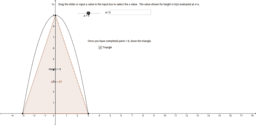[i]Goals[/i]
The overriding goal of these tasks and problems is provide students with opportunities to build their own functions in interesting contexts. We hope these tasks will help students think, talk, and write about things like:
[list]
[*]when a relation among variables determines a function;
[*]the domain and range of a function defined in experiential terms;
extreme values of a function;
[*]how the standard operations on functions are used, i.e. sum, difference, product, and quotient as well as composition of functions and the problem of defining inverse functions.
[/list]
[i]Commentary[/i]
[list]
[*]You may consider providing a graph as a possible scaffold. We did not include it because we felt it was important for students to make sense of the description and to create the graph themselves.
[*]For students who really struggle to visualize the dynamic aspect of this task, there is a dynamic tool available at: INSERT LINK
[/list]
[i]Two possible areas of extension: [/i]
[list]
[*]How do we represent the domain or range of a function differently when it is discrete as opposed to when it is continuous?
[*]What are different ways we could represent the functions in this task?
[/list]


